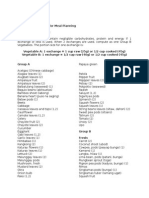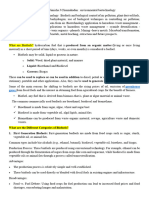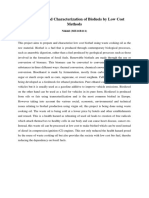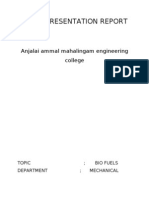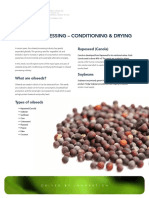0 ratings0% found this document useful (0 votes)
2 viewsScript Biofuel
Script Biofuel
Uploaded by
DewaMenjelaskan mekanisme biofuel
Copyright:
© All Rights Reserved
Available Formats
Download as DOCX, PDF, TXT or read online from Scribd
Script Biofuel
Script Biofuel
Uploaded by
Dewa0 ratings0% found this document useful (0 votes)
2 views2 pagesMenjelaskan mekanisme biofuel
Copyright
© © All Rights Reserved
Available Formats
DOCX, PDF, TXT or read online from Scribd
Share this document
Did you find this document useful?
Is this content inappropriate?
Menjelaskan mekanisme biofuel
Copyright:
© All Rights Reserved
Available Formats
Download as DOCX, PDF, TXT or read online from Scribd
Download as docx, pdf, or txt
0 ratings0% found this document useful (0 votes)
2 views2 pagesScript Biofuel
Script Biofuel
Uploaded by
DewaMenjelaskan mekanisme biofuel
Copyright:
© All Rights Reserved
Available Formats
Download as DOCX, PDF, TXT or read online from Scribd
Download as docx, pdf, or txt
You are on page 1of 2
Slide 1: Good morning everyone. Welcome to my presentation today.
First of all, let me introduce
myself, my name is Fadli Rezqi Ramdani, I am a student majoring in mechanical engineering at .
Muhammadiyah University Prof. Dr. HAMKA
Today I will discuss Biofuel, namely fuel that comes from biomass, namely plant material or algae or
animal waste.
Slide 2: Here I divide it into 4 points, namely: what is biofuel, types of biofuel, the process of making
biofuel, and finally the advantages and conclusions I draw from my presentation.
Slide 3: So what is biofuel?
Slide 4: Biofuel, namely fuel derived from biomass, namely plant material or algae or animal waste.
Because these raw materials can be replenished, biofuels are considered renewable fuels, unlike fossil
fuels such as coal, natural gas, and petroleum. So this is the meaning of Biofuel, then why should we
use biofuel. OK, next.
Slide 5: Why should we use biofuel? Firstly as alternative energy because perhaps the more we use of
our petroleum it will cause bad things in the future, starting from pollution and the exhaustion of
petroleum supplies. Second, it is environmentally friendly, because the things made from biofuel are
natural materials, different from the ones we often use, which come from fossils, so the smoke emitted
and the manufacturing process are very environmentally friendly. And third, it is very easy to refill so
that when we start to run out we can make more and even make as much as possible as a reserve
supply
Slide 6: Next are the types of Biofuel
Slide 7: Here there are 3 types of biofuel, the first is Biodiesel which is usually made from animal oil,
soybean oil, canola oil, palm oil, etc. The second is Bioethanol made from wheat, corn, sugar beets,
sugar cane, etc. And finally, Biogas is made from organic waste such as livestock manure, or kitchen
waste such as vegetables and fruit that have been used.
Slide 8: The process of making biodiesel involves several important steps to convert vegetable oils or
animal fats into biodiesel through a process called transesterification. Following are the main steps in
making biodiesel:
1. Selection and Collection of Raw Materials:
The main raw materials for making biodiesel are vegetable oils (such as palm oil, soybean oil,
sunflower seed oil) or animal fats. Used cooking oil (used oil) can also be used.
2. Filtering and Cleaning:
The oil or fat obtained needs to be filtered and cleaned from dirt and water. This process
includes:
Filtering: Removes solid particles.
Water Removal: Oil is heated to remove water content that could interfere with the
transesterification process.
3. Transesterification Process
This is the main stage in making biodiesel. This process involves a chemical reaction between
oil or fat and alcohol (usually methanol) with the help of a catalyst (usually a base such as
sodium hydroxide or potassium hydroxide). The steps are:
Mixing: Alcohol and catalyst are mixed to form methoxide.
Reaction: Methoxide is mixed with oil or fat and stirred at a temperature of about 60°C for 1-
2 hours.
Separation: The mixture is allowed to stand to separate the biodiesel (upper phase) and
glycerol (lower phase) layers.
4. Purification
The resulting crude biodiesel needs to be purified to remove traces of catalyst, alcohol, and
other contaminants. The purification process includes:
Washing: Biodiesel is washed with water to remove catalyst and glycerol.
Drying: Biodiesel is dried to remove residual water.
5. Quality Testing
The quality of the biodiesel produced is tested according to standards such as ASTM D6751
or EN 14214 to ensure that the biodiesel meets the specified specifications.
6. Storage
Biodiesel that meets quality standards is stored in appropriate storage tanks before being used
as fuel.
Slide 10: Ok next, we will discuss the advantages of biofuel
Slide 11: Using biofuels has various benefits, both from an environmental, economic and social
perspective. Here are some of the main advantages of using biofuels:
1. Environmentally Friendly
Reduces Greenhouse Gas Emissions: Biofuels produce less CO2 emissions compared to fossil
fuels. Its use can help reduce the greenhouse effect and combat climate change.
Biodegradable and Non-Toxic: Biofuels such as biodiesel are more easily decomposed
naturally and do not contain dangerous chemicals like fossil fuels.
2. Economic Benefits
Job Creation: The biofuel industry creates jobs in the agriculture, processing, and distribution
sectors. Supporting Local Agriculture: Biofuels can be produced from crops cultivated by
local farmers, increasing their income and welfare.
3. Waste Reduction
Biofuel can be produced from organic waste such as used cooking oil and agricultural
residues, helping to reduce waste disposal problems.
4. Good Engine Performance
Natural Lubricant Content: Biodiesel has better lubricating properties than fossil fuels, which
can help extend engine life. Reduction of Particulate Emissions: The use of biodiesel can
reduce emissions of fine particles that are harmful to human health.
5. Technology Development and Innovation
Stimulation of Research and Innovation: The demand for biofuels stimulates research and
development of new technologies in the field of renewable energy and alternative fuels.
In conclusion Biofuels are an important component in the global strategy to achieve a cleaner, safer
and more sustainable energy future. Support for the development and adoption of biofuels can have a
significant positive impact on the environment, economy and society.
Slide 12: That's all my presentation, hopefully we can all increase our knowledge and we can develop
this biofuel, more or less, I apologize and thank you all. Wassalamualaikum wr.wb
You might also like
- Cellular Healing DietDocument58 pagesCellular Healing DietAngelaGarcia-AscencioNo ratings yet
- Food Exchange ListsDocument19 pagesFood Exchange ListsEzra Minette Lasin100% (2)
- Chemistry Project On Green Chemistry: Bio-Diesel and Bio-PetrolDocument18 pagesChemistry Project On Green Chemistry: Bio-Diesel and Bio-PetrolFerry Sofat85% (20)
- Vegetable Oils and Fats On Chemical Tankers - Capt Ajit VadakayilDocument29 pagesVegetable Oils and Fats On Chemical Tankers - Capt Ajit VadakayilWisnu KertaningnagoroNo ratings yet
- Biofuels Notes in DetailDocument12 pagesBiofuels Notes in Detailnimisha joly chennakadanNo ratings yet
- Biodiesel Investigatory PaperDocument7 pagesBiodiesel Investigatory PaperJosh Aldrin SarioNo ratings yet
- LAB IV REPORT (Group 3)Document13 pagesLAB IV REPORT (Group 3)Sanjeev NehruNo ratings yet
- Chem ResearchDocument5 pagesChem ResearchRitika SunilNo ratings yet
- GREEN CHEMISTRY - Part-2Document12 pagesGREEN CHEMISTRY - Part-2Venkatesh PrasadNo ratings yet
- Chemistry Class 12 ProjectDocument14 pagesChemistry Class 12 ProjectGhost AnkanNo ratings yet
- Bio DiselDocument15 pagesBio DiselAmritansh JaiswalNo ratings yet
- Project Work of Chemistry On BiodieselsDocument23 pagesProject Work of Chemistry On BiodieselssushantNo ratings yet
- Chemistry Investigatory Project Class 12 - Green Chemistry - Bio Diesel and Bio PetrolDocument6 pagesChemistry Investigatory Project Class 12 - Green Chemistry - Bio Diesel and Bio PetrolsushantNo ratings yet
- Bio FuelDocument36 pagesBio FuelAmal ManojNo ratings yet
- Dokumen - Tips Chemistry Investigatory Project Class 12 Green Chemistry Bio Diesel andDocument34 pagesDokumen - Tips Chemistry Investigatory Project Class 12 Green Chemistry Bio Diesel andlegendgamerz893No ratings yet
- Bio DieselDocument15 pagesBio DieselAvnish BhasinNo ratings yet
- Formation of BiodieselDocument14 pagesFormation of BiodieselprabhatNo ratings yet
- Biodiesel Refers To A Non-Petroleum-Based Diesel Fuel Consisting of ShortDocument12 pagesBiodiesel Refers To A Non-Petroleum-Based Diesel Fuel Consisting of Shortchoureyshishir73No ratings yet
- Transfer Dock - Text - 20240608202159Document3 pagesTransfer Dock - Text - 20240608202159PrEc丨ᗝuSp尺ΔᑎAvNo ratings yet
- Countries That Have Used Biodiesel As FuelDocument12 pagesCountries That Have Used Biodiesel As Fueldecii nikmatussarahNo ratings yet
- Chemistry AssignmentDocument7 pagesChemistry AssignmentFakhir RehanNo ratings yet
- Green ChemistryDocument32 pagesGreen ChemistryAkshayNo ratings yet
- Chemistry Project On Formation of BiodieselDocument3 pagesChemistry Project On Formation of BiodieselYamuna MehtaNo ratings yet
- Chemistry ProjectDocument56 pagesChemistry Projectpradeep bijarniaNo ratings yet
- Chemistry Investigatory Project: Formation of Bio DieselDocument15 pagesChemistry Investigatory Project: Formation of Bio DieselHacker MNo ratings yet
- Introduction To Green ChemistyDocument21 pagesIntroduction To Green ChemistyHeartykingnkNo ratings yet
- Chemistry Project: Name: Febinesh Kannan DJ Class: Xii A'Document16 pagesChemistry Project: Name: Febinesh Kannan DJ Class: Xii A'Krishna KrNo ratings yet
- @###@project On Bio-DieselDocument24 pages@###@project On Bio-DieselNagula MalleshNo ratings yet
- Production of Biodiesel From Used Vegetable OilDocument4 pagesProduction of Biodiesel From Used Vegetable OilEmmanuelNo ratings yet
- Green Chemistry - BiodieselDocument21 pagesGreen Chemistry - Biodieselkavikumar venkatajalamNo ratings yet
- Biofuel and BiodieselDocument16 pagesBiofuel and Biodieseljoe100% (3)
- Ip ProjectDocument19 pagesIp ProjectSoham JadhavNo ratings yet
- Chemistryinvestigatoryproject-170126130926 (3) - RemovedDocument30 pagesChemistryinvestigatoryproject-170126130926 (3) - RemovedRaghav SharmaNo ratings yet
- Chemistry Investigatory Project: Formation of Bio DieselDocument16 pagesChemistry Investigatory Project: Formation of Bio Dieselparth9896upadhyayNo ratings yet
- Biodiesel ReportDocument26 pagesBiodiesel ReportItsura AnnetteNo ratings yet
- Biodiesel From Coconut Oil: A Renewable Alternative Fuel For Diesel EngineDocument5 pagesBiodiesel From Coconut Oil: A Renewable Alternative Fuel For Diesel EngineAde HadyNo ratings yet
- SodaPDF-merged-Merging ResultDocument15 pagesSodaPDF-merged-Merging ResultHardik RohitNo ratings yet
- Chemistry Investigatory Project: Formation of Bio DieselDocument15 pagesChemistry Investigatory Project: Formation of Bio DieselHardik RohitNo ratings yet
- Article PublicationDocument8 pagesArticle Publicationrikaseo rikaNo ratings yet
- Biofuel: 1-Bioethanol Is An Alcohol Made by Fermentation, Mostly From CarbohydratesDocument5 pagesBiofuel: 1-Bioethanol Is An Alcohol Made by Fermentation, Mostly From CarbohydratesTheAwein ChannelNo ratings yet
- A Review of The Biodiesel Sources and Production Methods: Vol 5, Number 1, 2020 ISSN: 2548-0332 e-ISSN 2636-7904Document10 pagesA Review of The Biodiesel Sources and Production Methods: Vol 5, Number 1, 2020 ISSN: 2548-0332 e-ISSN 2636-7904WAL MALOUNo ratings yet
- PROJECT On Preparation of BiodieselDocument25 pagesPROJECT On Preparation of BiodieselEDM RIOTNo ratings yet
- Low Cost Bio-Fuel ResearchDocument4 pagesLow Cost Bio-Fuel ResearchNikhil DasNo ratings yet
- Say Fa 41Document6 pagesSay Fa 41Gabriel MacLeodNo ratings yet
- JUPITER PUBLIC SCHOOL. Biodesel AssisgnmentDocument20 pagesJUPITER PUBLIC SCHOOL. Biodesel AssisgnmentAditya MoharanaNo ratings yet
- Chemistry Investigatory Project: Formation of Bio DieselDocument15 pagesChemistry Investigatory Project: Formation of Bio DieselNithish KumarNo ratings yet
- 1.1 BackgroundDocument24 pages1.1 BackgroundFirdaNo ratings yet
- Chemistry ProjectDocument26 pagesChemistry ProjectMohammad HassanNo ratings yet
- Biodiesel: Submitted byDocument17 pagesBiodiesel: Submitted bysai mohan100% (1)
- Presentation 30Document21 pagesPresentation 30ashishkhatik16No ratings yet
- Chemistry Project 2Document31 pagesChemistry Project 2Harshit SinghNo ratings yet
- Biofuel (Antu)Document33 pagesBiofuel (Antu)rajaraji33No ratings yet
- Biofuels PresentationDocument9 pagesBiofuels Presentationronald100% (1)
- BioethanolDocument16 pagesBioethanolshivani raina100% (2)
- The Biodiesel Process: Acid EsterificationDocument2 pagesThe Biodiesel Process: Acid EsterificationJack JackNo ratings yet
- Biodiesel ProjectDocument10 pagesBiodiesel Projectparas devNo ratings yet
- Name: Mustafa Khader Abdel Abbas. Stage: (Morning) .: Biodisel Processing and ProductionDocument10 pagesName: Mustafa Khader Abdel Abbas. Stage: (Morning) .: Biodisel Processing and Productionمصطفى الجبوريNo ratings yet
- Research Papers On BiodieselDocument6 pagesResearch Papers On Biodieselpeputaqlg100% (3)
- Paper Presentation Report: Anjalai Ammal Mahalingam Engineering CollegeDocument15 pagesPaper Presentation Report: Anjalai Ammal Mahalingam Engineering CollegeManjesh ThilakNo ratings yet
- Chemistry ProjectDocument8 pagesChemistry ProjectVanshika MiglaniNo ratings yet
- BiodieselDocument17 pagesBiodieselJason SinghNo ratings yet
- BiodieselDocument15 pagesBiodieselJason KnightNo ratings yet
- Biodiesel Production101: Homebrew Edition: A Do It Yourself Guide to Produce Biodiesel on Your BackyardFrom EverandBiodiesel Production101: Homebrew Edition: A Do It Yourself Guide to Produce Biodiesel on Your BackyardNo ratings yet
- CT IUTqo O7 y O3 NJedDocument178 pagesCT IUTqo O7 y O3 NJedhamzaNo ratings yet
- Allergy Ingredient GuideDocument189 pagesAllergy Ingredient GuideRobin LopezNo ratings yet
- Fatty Acid Composition and Quality Characteristic of Some Vegetable OilsDocument5 pagesFatty Acid Composition and Quality Characteristic of Some Vegetable OilsLuki Wahyuning TiyasNo ratings yet
- Density, Viscosity, and Surface Tension of Five Vegetable Oils at Elevated Temperatures: Measurement and ModelingDocument18 pagesDensity, Viscosity, and Surface Tension of Five Vegetable Oils at Elevated Temperatures: Measurement and ModelingMUHAMMAD LUFFINo ratings yet
- Assessment of Supply Chain Management of Sesame Seed in Pakokku Township, Magway Region, MyanmarDocument10 pagesAssessment of Supply Chain Management of Sesame Seed in Pakokku Township, Magway Region, MyanmarPremier PublishersNo ratings yet
- Pakistans Import Management StrategyDocument23 pagesPakistans Import Management StrategyAli HusanenNo ratings yet
- Mustard Seed ProfileDocument15 pagesMustard Seed Profilejaldikar@gmail.comNo ratings yet
- Oilseed Processing - Conditioning & Drying: Rapeseed (Canola)Document4 pagesOilseed Processing - Conditioning & Drying: Rapeseed (Canola)Adrian CursaruNo ratings yet
- Issariyakul DissertationDocument61 pagesIssariyakul DissertationRichard ObinnaNo ratings yet
- Literature Review On Vegetable OilDocument8 pagesLiterature Review On Vegetable Oilbteubwbnd100% (1)
- Cooking OilDocument6 pagesCooking OilMAGOMU DAN DAVIDNo ratings yet
- Latihan BimbelDocument7 pagesLatihan BimbelFendy Eko HariyantoNo ratings yet
- Study of Fatty Acid Profile in Edible Oil and Used Cooking OilDocument50 pagesStudy of Fatty Acid Profile in Edible Oil and Used Cooking OilDhanasekar VNo ratings yet
- 2 Determination of Mineral Content of Oil Bean (Ukpaka) Oil ChidimmaDocument20 pages2 Determination of Mineral Content of Oil Bean (Ukpaka) Oil ChidimmaokekeNo ratings yet
- Chapter 3 MACRONUTRIENTSDocument11 pagesChapter 3 MACRONUTRIENTSSami InglesNo ratings yet
- Foods of The World Supplement Number TwoDocument28 pagesFoods of The World Supplement Number TwoKenneth100% (1)
- Carrier Oil Shelf LifeDocument3 pagesCarrier Oil Shelf LifeAna ThesecretiveNo ratings yet
- Prediction of Cloud Points of BiodieselDocument6 pagesPrediction of Cloud Points of BiodieselRene Juan Gino Garcia MadariagaNo ratings yet
- Strategic Marketing Presentation On Gokul RefoilsDocument34 pagesStrategic Marketing Presentation On Gokul RefoilsChandan PahelwaniNo ratings yet
- Sime Darby Plantation: February 2011Document29 pagesSime Darby Plantation: February 2011emmanuelNo ratings yet
- Potensi KS SBG Pangan FungsionalDocument57 pagesPotensi KS SBG Pangan Fungsionalcitra sinagaNo ratings yet
- Physicochemical Properties of Terminalia Catappa Seed Oil As A Novel Dietary Lipid SourceDocument9 pagesPhysicochemical Properties of Terminalia Catappa Seed Oil As A Novel Dietary Lipid Sourcealem010No ratings yet
- Cooking Oil Comparison Chart Teacher VersionDocument3 pagesCooking Oil Comparison Chart Teacher Versionak siddikiNo ratings yet
- Teaching Green Chemistry With Epoxidized Soybean Oil: Homar Barcena, Abraham Tuachi, and Yuanzhuo ZhangDocument5 pagesTeaching Green Chemistry With Epoxidized Soybean Oil: Homar Barcena, Abraham Tuachi, and Yuanzhuo ZhangShorihatul InayahNo ratings yet
- Bio DisealDocument5 pagesBio DisealLayuger Acu LlessojNo ratings yet
- FWD Registration Certificate Generated - FSSAI Food Licensing & Registration System PDFDocument4 pagesFWD Registration Certificate Generated - FSSAI Food Licensing & Registration System PDFTanuj BishtNo ratings yet
- Vegetable Oil Quenchants: Calculation and Comparison of The Cooling Properties of A Series of Vegetable OilsDocument12 pagesVegetable Oil Quenchants: Calculation and Comparison of The Cooling Properties of A Series of Vegetable OilsAndreea CristinaNo ratings yet

